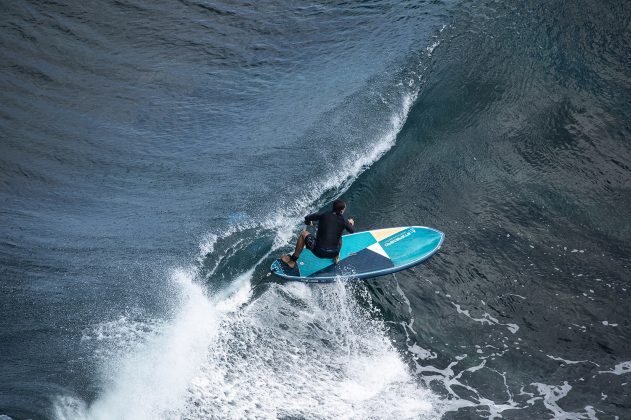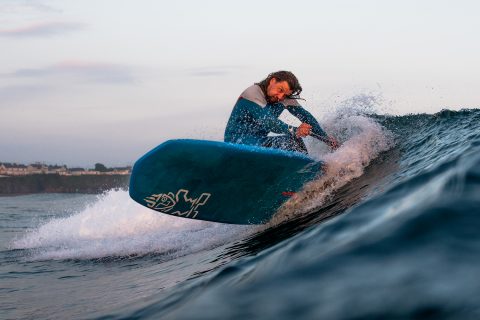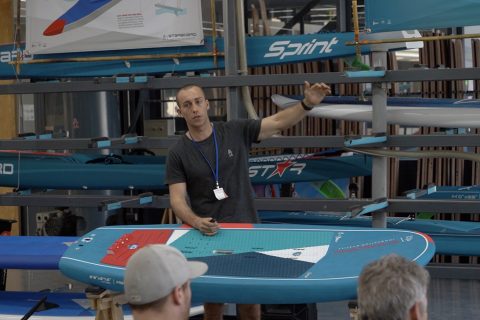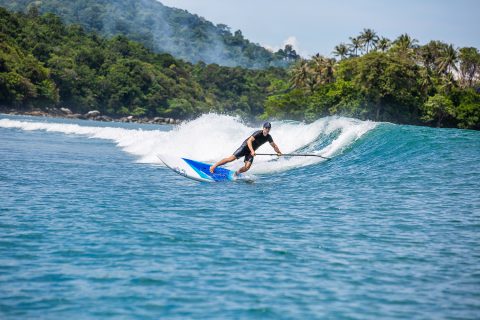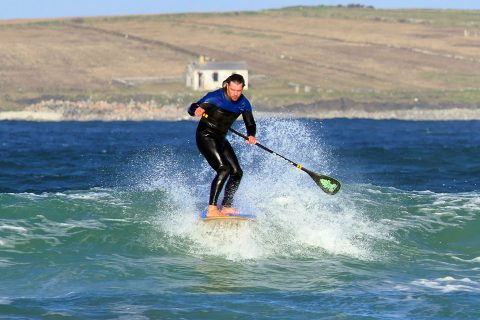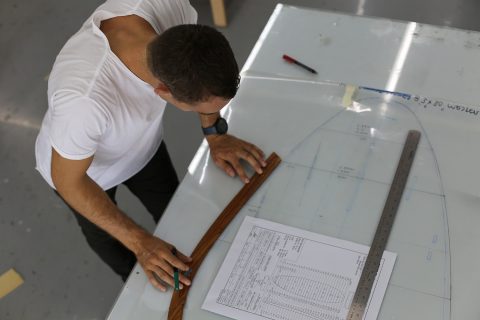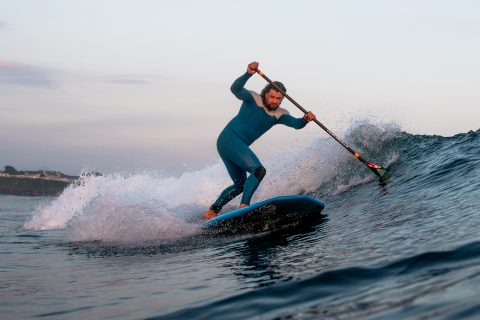What Lies Beneath
From our Mid Summer 2021 issue, Finn Mullen talks with Ollie O’Reilly, Senior Product Manager for Starboard SUP, about some of the basic parameters of a SUP surf shape.
Photos: Nathan Lawrence // Rocio Torado // Georgia Schofield // Ian Mitchinson // Darragh Gorman @ lighthouse. industries.
Ollie – In general concaves create lift and speed – aconcave is where the centre of the board is lower than the rail line. It also provides a level of stability as it simulates the
catamaran concept. Often referred to as a single concave, it is normally used at the entry of the nose as it allows you to have good glide and entry into waves. It also provides a level of
tracking as it funnels the water through the centre, making the board paddle straighter, helping to get into waves.
The primary function of a concave to remember is speed, but it also helps tracking and stability. Most of the Starboard surf ranges feature a single concave in the nose.
Ollie – A double concave splits the water into two channels. The centre of the board is often level with the rail and the sides are concaved and this is often used in the mid-section of the board as it helps it roll from rail to rail. It’s a combination of the concave and vee – speed from the two concaves and turning ability from the central vee – which allows the board to turn more easily as you can engage the rail from the midpoint of the board. Double concave normally is used to blend a single nose concave through to a vee tail. Boards like the Starboard Longboard range use a double concave nearly through the entire board, as it needs both speed and easy rail-to-rail turning.
Ollie – Longer length = faster and longer lasting glide, so better for longer distance paddles. Generally longer boards have more stability, more swing weight, but are more effort to turn and slower to pivot.
Shorter length = more manoeuvrable, fits in tighter pockets of the wave, less swing weight, generally less glide, lower volume, less stable and more for higher performance surfing.
The length and width of the board will change based on the type of board, e.g. a race board can be 14’0″, while a short board for sup surfing can be as short as 6’8″. The conditions, type of use, and rider ability will all determine the board length and width. A longer board will have a longer waterline, increasing the glide, making it faster to paddle. A shorter board will be slower to paddle but much easier to manoeuvre and turn. Generally speaking, a beginner getting into sup surfing and paddling should look for a board around 9’5″ up to 11″ and from 30″ to 34″ wide, depending on skill level and rider weight. A wider board will be more stable for heavier riders, a narrower board will easier to manoeuvre and best for lighter riders. For more advanced sup surfing, a shorter board will fit tighter in the pocket and be easier to perform more radical turns in critical sections of the wave without the nose catching and having less swing weight. However, a longer board might offer faster down-the-line speed (suited for bigger waves) and easier entry into waves. Outline also affects the dimensions of a board. A short and wide board, e.g. the Starboard Hyper Nut, might give you greater manoeuvrability compared to a longer, narrower board, e.g. gun style, which is built for speed.
Ollie – Constructions or technologies will also affect the performance and feel of the board in the water. In general, surfboards are a composite construction, using dry fibres with thermoset resins to create a composite material. In simplest terms, the construction has a foam core, which is used to create the shape of the board. Then woven fibres are wetted out with resin and wrap around the core. Multiple layers are used as well as reinforcements in critical areas to strengthen impact strength, stiffness or total breakage. Weight is an important factor in performance. In general, glass fibre boards are heavier than carbon fibre boards. A lighter board will go faster, be easier to manoeuvre and easier to carry, but generally are much more expensive. Glass fibre tends to be less expensive and heavier, but at great price points.
Starboard offers a range of technologies at different weights, price points, strengths and skill levels. Currently these are:
Blue Carbon Pro and Blue Carbon – lightest and strongest.
Starlite – full wood deck, strong impact resistant rails, extra reinforcements and a mid price point.
Lite Tech – fantastic value price point, solid tech.
ASAP – designed for schools / centres / clubs.
Ollie – Fins are used to principally track and guide the board. If you
paddled a board with no fins, it would feel very loose and hard to paddle straight. A fin will create straight-line tracking and also add a level of lateral stability. Side fins will give you drive, bite and control through turns.There are 4 main fin setups:
And the design of the fin can be broken down into:
Ollie – Rails refer to the sides of the board and run the full length and are used to engage on the wave face to help the board generate speed, grip and turn on the wave. Basically rails determine how water will flow around the board and how it performs on the wave – mainly focussing on grip and release. There are two main types of rails, soft and hard, which also differ on the amount of volume and rounded or sharp tuck edges.
Hard rails mainly refer to the tuck line having a sharp edge, giving more bite and hold. They are generally less volume and used at the tail of the board for creating a fast release and engaging / gripping on steeper sections of the wave. These allow the board to sink and turn more responsively, but are less forgiving. A pro board will have sharp, hard rails towards the tail.
Rail shape/foil, refers to the shape of the rail in relation to the apex, the widest point of the outline. This will affect how the rails bite into the wave.
The term 50/50 means the apex is in the middle of the rail, creating a similar rail shape above and below. This is often used in the middle of the board with soft rails. The term 60/40 – means the apex is lower, sharper and is often used when transitioning from the middle to the tail of the board and the term 80/20 means more down turned rails, where the apex is very low and therefore bites very early when applying pressure. These are used for instance on the 2021 Starboard Pro boards, our high performance boards.
Ollie – Channel bottoms are often used towards the tail of boards, primarily around the fins, although some feature centred channels through to the nose. We tested these a few years ago before adding them to the 2019/2020 Pro range. Channels help the water release and direct the flow through the tail, and can help create speed, grip through turns, a release point and tracking. Often you can allow the channels to take some of the work off the fins for tracking, allowing you to use smaller fins, for example like in a traditional bonzer shape.
Finn – Finally, can you talk about an issue close to a lot of SUP surfers’ hearts – stability!
Ollie – Stability when referring to SUP is generally talking about how stable a board is to stand on. It mainly considers the lateral stability from side to side, but also the trim from nose to tail. The main reference for stability is volume. In general a rider needs at very minimum the same amount of litres as their body weight for the board to float. But in general, depending on skill levels, riders normally have more litres above their weight. An advanced rider for surfing might only have between 5-10 litres above their weight, while a beginner might need 30-50 litres plus.
It depends on the shape of the board, skill level and conditions. For instance, Starboard race boards have always had drastically more volume than most competitors, but every time we added more – we gained speed and stability. The key thing about volume is the placement of the volume and how it is distributed. Within surfing, most of the volume sits in the middle section of the board, as that is where you stand most of the time.
The volume decreases as the board gets thinner towards the tail to allow the rider to push and drive through turns. Less volume at the tail makes it more responsive when turning, as there it requires less pressure to sink the foam. Nose volume is also less to reduce swing weight and make the board easier to rotate with less effort. The shape of the board will often determine how stable a board feels. E.g. an inflatable will often feel very corky as it has a lot of volume on the rails, which when displaced creates a sudden upsurge on the rail. Oppositely, thin-railed boards can sometimes feel more stable as the rails sit under the waterline, creating more resistance to roll sideways.
SUP International

